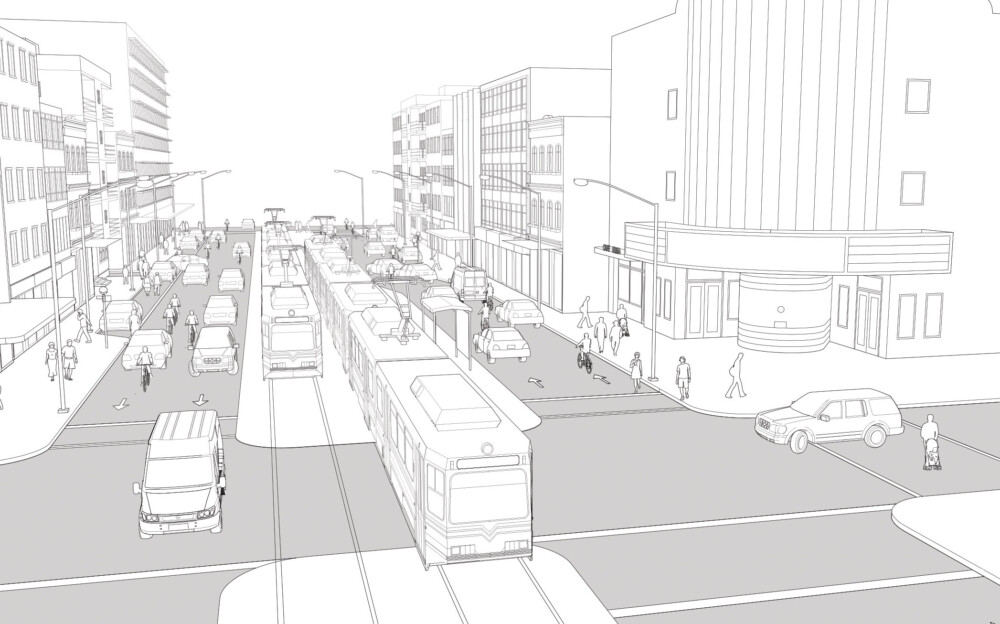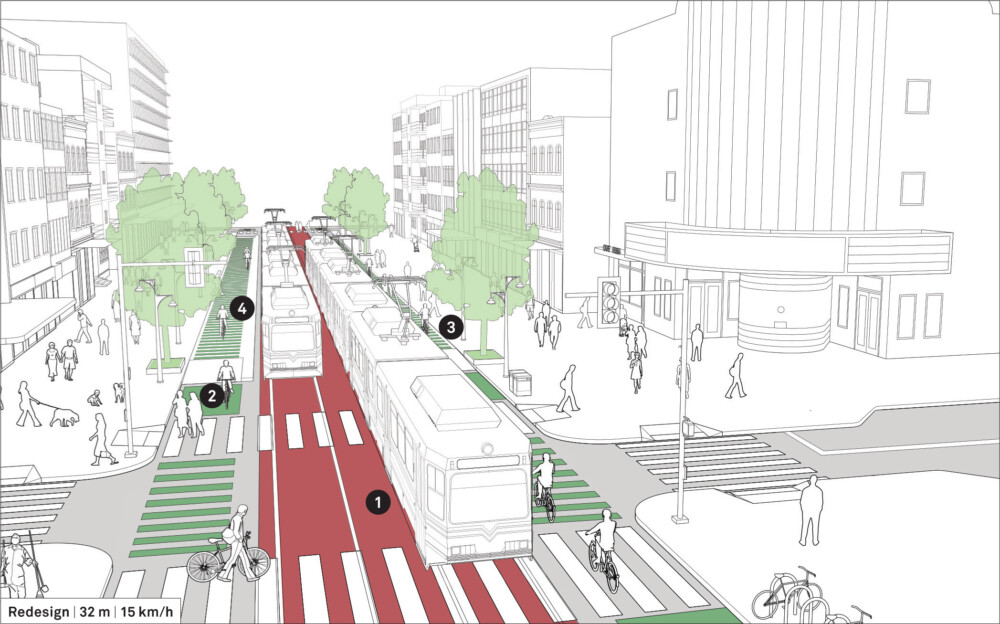-
About Streets
- Introduction
- Defining Streets
-
Shaping Streets
- The Process of Shaping Streets
- Aligning with City and Regional Agendas
- Involving the Right Stakeholders
- Setting a Project Vision
- Communication and Engagement
- Costs and Budgets
- Phasing and Interim Strategies
- Coordination and Project Management
- Implementation and Materials
- Management
- Maintenance
- Institutionalizing Change
- Measuring and Evaluating Streets
-
Street Design Guidance
- Designing Streets for Great Cities
- Designing Streets for Place
-
Designing Streets for People
- Utilities and Infrastructure
- Operational and Management Strategies
- Design Controls
-
Street Transformations
- Streets
-
Intersections
- Intersection Design Strategies
- Intersection Analysis
- Intersection Redesign
- Mini Roundabout
- Small Raised Intersection
- Neighborhood Gateway Intersection
- Intersection of Two-Way and One-Way Streets
- Major Intersection: Reclaiming the Corners
- Major Intersection: Squaring the Circle
- Major Intersection: Cycle Protection
- Complex Intersection: Adding Public Plazas
- Complex Intersection: Improving Traffic Circles
- Complex Intersection: Increasing Permeability
- Resources
Global Street Design Guide
-
About Streets
- Introduction
- Defining Streets
-
Shaping Streets
Back Shaping Streets
- The Process of Shaping Streets
- Aligning with City and Regional Agendas
- Involving the Right Stakeholders
- Setting a Project Vision
- Communication and Engagement
- Costs and Budgets
- Phasing and Interim Strategies
- Coordination and Project Management
- Implementation and Materials
- Management
- Maintenance
- Institutionalizing Change
-
Measuring and Evaluating Streets
Back Measuring and Evaluating Streets
-
Street Design Guidance
-
Designing Streets for Great Cities
Back Designing Streets for Great Cities
-
Designing Streets for Place
Back Designing Streets for Place
-
Designing Streets for People
Back Designing Streets for People
- Comparing Street Users
- A Variety of Street Users
-
Designing for Pedestrians
Back Designing for Pedestrians
- Designing for Cyclists
-
Designing for Transit Riders
Back Designing for Transit Riders
- Overview
- Transit Networks
- Transit Toolbox
-
Transit Facilities
Back Transit Facilities
-
Transit Stops
Back Transit Stops
-
Additional Guidance
Back Additional Guidance
-
Designing for Motorists
Back Designing for Motorists
-
Designing for Freight and Service Operators
Back Designing for Freight and Service Operators
-
Designing for People Doing Business
Back Designing for People Doing Business
-
Utilities and Infrastructure
Back Utilities and Infrastructure
- Utilities
-
Green Infrastructure and Stormwater Management
Back Green Infrastructure and Stormwater Management
-
Lighting and Technology
Back Lighting and Technology
-
Operational and Management Strategies
Back Operational and Management Strategies
- Design Controls
-
Street Transformations
-
Streets
Back Streets
- Street Design Strategies
- Street Typologies
-
Pedestrian-Priority Spaces
Back Pedestrian-Priority Spaces
-
Pedestrian-Only Streets
Back Pedestrian-Only Streets
-
Laneways and Alleys
Back Laneways and Alleys
- Parklets
-
Pedestrian Plazas
Back Pedestrian Plazas
-
Pedestrian-Only Streets
-
Shared Streets
Back Shared Streets
-
Commercial Shared Streets
Back Commercial Shared Streets
-
Residential Shared Streets
Back Residential Shared Streets
-
Commercial Shared Streets
-
Neighborhood Streets
Back Neighborhood Streets
-
Residential Streets
Back Residential Streets
-
Neighborhood Main Streets
Back Neighborhood Main Streets
-
Residential Streets
-
Avenues and Boulevards
Back Avenues and Boulevards
-
Central One-Way Streets
Back Central One-Way Streets
-
Central Two-Way Streets
Back Central Two-Way Streets
- Transit Streets
-
Large Streets with Transit
Back Large Streets with Transit
- Grand Streets
-
Central One-Way Streets
-
Special Conditions
Back Special Conditions
-
Elevated Structure Improvement
Back Elevated Structure Improvement
-
Elevated Structure Removal
Back Elevated Structure Removal
-
Streets to Streams
Back Streets to Streams
-
Temporary Street Closures
Back Temporary Street Closures
-
Post-Industrial Revitalization
Back Post-Industrial Revitalization
-
Waterfront and Parkside Streets
Back Waterfront and Parkside Streets
-
Historic Streets
Back Historic Streets
-
Elevated Structure Improvement
-
Streets in Informal Areas
Back Streets in Informal Areas
-
Intersections
Back Intersections
- Intersection Design Strategies
- Intersection Analysis
- Intersection Redesign
- Mini Roundabout
- Small Raised Intersection
- Neighborhood Gateway Intersection
- Intersection of Two-Way and One-Way Streets
- Major Intersection: Reclaiming the Corners
- Major Intersection: Squaring the Circle
- Major Intersection: Cycle Protection
- Complex Intersection: Adding Public Plazas
- Complex Intersection: Improving Traffic Circles
- Complex Intersection: Increasing Permeability
- Resources
- Guides & Publications
- Global Street Design Guide
- Streets
- Avenues and Boulevards
- Transit Streets
- Example 2: 32 m
Example 2: 32 m


Existing Conditions
The street illustrated above plays an important role in the city’s network, connecting commercial hubs to neighborhoods with a center-running transit spine. At times, transit is physically separated to increase efficiency.
This two-way street has two travel lanes in each direction with medium traffic volumes and high pedestrian activity.
Pedestrian access across the street is allowed at designated, but limited, points where crossings are not universally accessible.
Pedestrians spill onto the roadbed due to limited space for commercial and pedestrian activity.
Transit riders face difficulty in crossing multiple travel lanes to get from the transit stop on the central median to the sidewalk.
Frequent curb cuts result in multiple turning and weaving conflicts, rendering the street unsafe for cyclists.

Kolkata, India
Design Guidance
Reconfigure this street to re-establish it as an important commercial corridor. Restrict or filter through-traffic and separate transit, cycle, and pedestrian zones within the right-of-way. Prioritize stopping-and-staying activities.
![]() Improve center-running mass transit by raising the roadbed at the transit stops to increase boarding efficiency and accessibility. See: Transit Facilities.
Improve center-running mass transit by raising the roadbed at the transit stops to increase boarding efficiency and accessibility. See: Transit Facilities.
Vehicle traffic may be fully prohibited, restricted to certain times of day, or required to turn off after one or two blocks to manage volume and preserve pedestrian and transit priority.
Provide dedicated space within the curb zone to accommodate trees, street furniture, vendors, cycle racks, and other elements.
![]() Add dedicated cycle lanes on both sides of the street. Separate cyclists at transit stops and provide two-stage turns at intersections to ensure cyclists do not cross in-street rails except at near 90-degree angles. See: Cycle facilities.
Add dedicated cycle lanes on both sides of the street. Separate cyclists at transit stops and provide two-stage turns at intersections to ensure cyclists do not cross in-street rails except at near 90-degree angles. See: Cycle facilities.
Provide a minimum buffer of 0.5 m from transit in each direction to avoid conflicts between cyclists and passengers boarding the transit.
![]() Place transit stop amenities behind the cycle lanes to offer shelter for passengers while maintaining a continuous clear path for cyclists. See: Cycle Facilities.
Place transit stop amenities behind the cycle lanes to offer shelter for passengers while maintaining a continuous clear path for cyclists. See: Cycle Facilities.
![]() Where cycle lanes encounter transit stops, ramp lanes up to sidewalk level to allow accessible transit boarding.
Where cycle lanes encounter transit stops, ramp lanes up to sidewalk level to allow accessible transit boarding.
Provide distinct markings on cycle lanes at transit stops to indicate crossing paths with transit passengers.
Restrict loading and deliveries to off-peak hours.

Budapest, Hungary
Adapted by Global Street Design Guide published by Island Press.
Next Section —